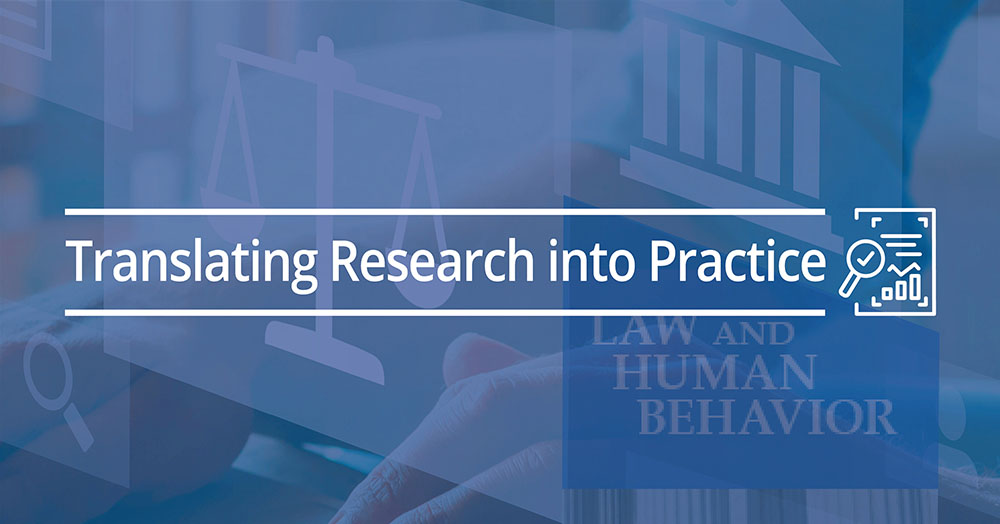Featured Article
Article Title
Detecting Criminal Intent in Social Interactions: The Influence of Autism and Theory of Mind
Authors
Zoe Michael; College of Education, Psychology and Social Work, Flinders University
Neil Brewer; College of Education, Psychology and Social Work, Flinders University
Abstract
Objective: Defense attorneys sometimes suggest that social-cognitive difficulties render autistic individuals vulnerable to involvement in crime, often arguing that theory of mind (ToM) difficulties that undermine inferences about others’ intentions underpin this vulnerability. We examined autistic adults’ ability to respond adaptively to criminal intent during interactions and whether difficulties were associated with poor ToM.
Hypotheses: Compared with nonautistic adults, autistic adults were expected to be less likely to respond adaptively to another’s criminal intent and less likely to do so early in interactions, with poorer performance associated with ToM difficulties.
Method: We developed the Suspicious Activity Paradigm, in which autistic (n = 102) and nonautistic (n = 95) adults listened (as if participating in an interaction) to audio scenarios in which cues suggesting their impending involvement in a crime gradually emerged. At periodic intervals, they were required to indicate how they would react toward the other person’s behavior, with response coding reflecting detection of, and adaptive responding to, suspicious activity.
Results: We observed similar patterns of suspicion and adaptive responses in autistic and nonautistic adults as the scenarios progressed. Regardless of diagnostic status, pronounced ToM difficulties and low verbal ability were independently associated with a lower likelihood of reporting suspicion and responding adaptively.
Conclusions: Our results do not support the perspective that autistic adults are uniquely vulnerable to crime involvement due to an inability to recognize and respond adaptively to suspicious behavior. The potential for heightened criminal vulnerability was associated with significant ToM difficulties (and verbal ability) regardless of autism diagnostic status, although such difficulties were more prevalent in the autistic sample. The finding that pronounced ToM difficulties may heighten criminal vulnerability for both autistic and nonautistic individuals challenges the validity of a generalized “autism” legal defense based on assumed rather than measured ToM difficulties.
Keywords
autism, criminal intent, intelligence, mindreading, theory of mind
Summary of Research
“When an autistic individual appears in court charged with a crime, it is not uncommon for their defense attorney to argue that their autism diagnosis should be considered a mitigating factor when assessing culpability… Defense attorneys may enlist expert testimony from psychologists or psychiatrists who will likely highlight that key elements underpinning a diagnosis of autism are pervasive problems with social communication and interaction, as indicated in the Diagnostic and Statistical Manual of Mental Disorders, fifth edition, text revision of Mental Conditions. Further, it may be suggested that such impairments are underpinned by social-cognitive difficulties, sometimes referred to as Theory of Mind (ToM) or mindreading difficulties” (p. 90)
“Consequently, the current research had two main objectives. One was to examine whether, when compared with nonautistic adults of similar intellectual ability, autistic individuals can detect and respond adaptively during a social interaction when another individual is behaving suspiciously and, consequently, they are at risk of becoming ensnared in a criminal act. The second objective was to determine whether ToM difficulties—difficulties in taking the perspective of others and reading their intentions—that purportedly characterize autistic individuals undermine their capacity to detect and respond adaptively to suspicious behavior on the part of others” (p. 90)
“To address our two main objectives, in Study 1, we developed and evaluated a new paradigm—the SAP—that we considered would provide a more ecologically valid measure of the ability to detect and respond to suspicious behavior than the signal detection task developed by Brewer, Lucas, et al. (2023). Our aim was to establish, using sizable samples of nonautistic individuals, that (a) the SAP paradigm was capable of demonstrating that—as interactions unfolded and it became increasingly apparent that involvement in some criminal activity was looming—participants recognized this and responded adaptively, and (b) participants’ behaviors could be reliably coded by independent observers. In Study 2, we used the SAP paradigm to compare large samples of autistic and nonautistic adults to probe the relationships between autism, ToM, and the detection of and response to suspicious behavior. We tested the hypothesis that, when compared with nonautistic adults, autistic adults had greater difficulty detecting and responding adaptively to suspicious behavior within interactions and possibly were less likely to do so relatively early in an interaction. We also tested whether, after controlling for verbal ability, ToM difficulties were associated with less sensitive detection and adaptive responding to suspicious behavior. In Study 2, we also conducted exploratory examinations of (a) the relationships between degree of autistic characteristics and SAP responding, (b) differences in SAP responding associated with gender identification, and (c) the tendency to comply with others’ requests despite having recognized their problematic nature” (p. 91-92).
“In the current research, we developed a novel paradigm—the SAP—that assessed whether participants could recognize cues signaling that a criminal act was unfolding and respond appropriately (Study 1). We established that the paradigm was an effective way of demonstrating people’s ability to recognize and respond adaptively to suspicious behavior on the part of an interaction partner” (p. 102).
“We highlight six findings. First, we demonstrated remarkably similar patterns of adaptive responding and suspicion responses across the crime (and noncrime) scenarios in samples of autistic and nonautistic adults in Study 2. At no segment of the crime scenarios did the autistic participants provide lower percentages of suspicion and adaptive behavior responses than nonautistic participants. Moreover, the proportion of participants who indicated suspicion in the noncrime scenario was low in both groups. Second, those with higher degrees of autistic traits were more, rather than less, likely to (a) report suspicious behavior at early scenario segments in three of the crime scenarios, and (b) respond adaptively in two of those scenarios” (p. 102).
“Third, our regression analyses indicated that both verbal IQ and ToM—but not autism diagnostic status—were significant predictors of the number of suspicion and adaptive behavior responses reported by participants. Fourth, comparisons of SAP responding revealed that, despite similar verbal IQ levels, individuals who obtained very low scores on the ToM task were less likely than high ToM performers to report suspicion and respond adaptively at early stages of the interactions. Fifth, an examination of SAP response patterns for males and females hint at the possibility that female autistic individuals may be more likely to detect and respond to suspicious behavior. But given the relatively weak effects, further evidence is required to confirm whether this pattern is reliable. Finally, when we examined the frequency with which autistic and nonautistic individuals indicated that they would comply with a problematic request, despite being suspicious about what they were being asked to do, we did not detect a significant difference” (p. 102-103).
Translating Research into Practice
“Several findings of the current research are particularly relevant to our understanding of whether autistic individuals may be especially vulnerable to becoming involved in crime. First, consistent with Brewer, Lucas, et al.’s (2023) findings, the ability to detect and respond to suspicious behavior within interactions did not distinguish autistic and nonautistic adult samples. Thus, the notion that an autism diagnosis is associated with an inherent inability to read cues to suspicion and respond adaptively was not supported by these data. These findings do not necessarily refute inferences that have sometimes been drawn from case studies of autistic individuals’ involvement in crime. But it may be that, whenever an autistic individual offends and causal factors are being canvassed, the possibility that ToM difficulties, often assumed to be linked to an autism diagnosis, might have contributed is more salient than when there is no suggestion that the offender may be autistic.
Second, our finding that autistic individuals who were suspicious about what they were being asked to do were not significantly more likely than nonautistic individuals to accede to such requests is not consistent with notions that autistic individuals may be uniquely vulnerable because they are dispositionally compliant. Thus, our findings are at odds with Chandler et al.’s (2019) findings that we discussed in the Introduction. Recall, however, that although Chandler et al. showed that autistic adults were more likely than nonautistic adults to comply with an unreasonable request, the nature of the request and the reasons they gave for complying make it difficult to equate their findings with likely compliance when faced with criminal coercion. Given (a) other studies of compliance using self-report rather than behavioral measures have reported mixed and indecisive outcomes, and (b) our compliance findings, obtained under specific contextual conditions, must be regarded as preliminary, it would be premature to draw decisive conclusions about the likely responses of autistic adults to attempted criminal coercion.
Third, consistent with other recent findings, ToM difficulties did not characterize all autistic adults. This highlights the importance of emphasizing individual characteristics within the context of an autism diagnosis when considering cases involving autistic defendants. Although suggesting that an autistic person’s ToM difficulties contributed to their offending may be entirely appropriate in some cases, evidence from a formal assessment of an individual’s ToM difficulties should be provided rather than assumed.
Fourth, there was an association between ToM difficulties and the detection of suspicious behavior that was reflected in individuals with very low ToM failing to pick up suspicious cues or to respond adaptively at an early stage of interactions. This pattern was present regardless of the presence of an autism diagnosis, thereby more generally implicating ToM difficulties as a possible factor contributing to criminal vulnerability. We reiterate, however, that consistent with findings reported elsewhere, the prevalence of severe ToM difficulties, though relatively low overall in adult samples, was nevertheless higher in the autistic than the nonautistic sample. Thus, despite our overall findings, the formal assessment of ToM as a possible risk factor for autistic defendants is merited. Instruments such as the A-ToM-Q, the A-ToM, or the Frith-Happé animations, which have been tested on relatively large samples of autistic adults, will highlight individuals with significant ToM difficulties and can be readily accessed and used for such assessments. Taken together, our findings indicate that a more nuanced understanding of autism and ToM as criminological risk factors for autistic adults is needed” (p. 103)
Other Interesting Tidbits for Researchers and Clinicians
“Although our findings are consistent with some researchers’ conclusions that crime prevalence studies indicate autistic adults are no more likely to offend than nonautistic adults, it is important to recognize the limitations of our research and identify important research questions. First, we examined whether autistic individuals could recognize and respond adaptively when another individual was behaving suspiciously. There are, however, other contexts not captured by the SAP scenarios in which the severe ToM difficulties that are detected in a small proportion of autistic adults may represent a significant risk factor” (p. 103).
“Second, the design of the SAP obviously does not simulate the many complex interpersonal demands of natural social interactions and the influence of social pressures on decision making. Developing even more sophisticated behavioral measurement techniques will be a complex and challenging, but necessary, undertaking. Third, and relatedly, the SAP is not a pure measure of behavior, but rather, a measure of people’s intentions to respond in a certain way. Fourth, although the current research project focused on the relationship between ToM and the detection of, and response to, suspicious behavior, several other common characteristics of autism—especially when combined with ToM difficulties—could potentially further elevate criminal vulnerability and victimization” (p. 103-104).
“Fifth, the nature of the Prolific platform used by autism researchers does not allow us to be absolutely certain that those individuals registered in the autism category had received an autism diagnosis from a qualified professional… Sixth, our findings highlight the potential importance of intellectual ability in negotiating potentially problematic social interactions. The association between SAP performance and verbal ability was anticipated, given (a) the reliance on spoken dialogue and verbal cues within the SAP and (b) previous research documenting verbal ability as an independent predictor of “dodginess” discrimination. Although we targeted individuals with verbal IQs of 85 and above, impaired intellectual functioning often co-occurs with an autism diagnosis, with some estimates suggesting approximately 30% co-occurrence. Consequently, the current findings cannot be generalized to those autistic adults with verbal IQs below 85” (p. 104).
“Seventh, by virtue of attracting an autistic sample that included a substantial representation of females—thereby addressing expressed concerns about the neglect of possible sex differences in autism (e.g., Nordahl, 2023)—our data provide a very tentative suggestion that there may be gender differences in the detection of, and response to, suspicious behavior by autistic adults” (p. 104).













